MODERN TURTLE TRACKS
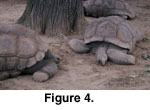 Several specimens of large chelonid
Galapagos tortoises (Geochelone elephantopus) were made available by the
Philadelphia Zoo (Figure 4,
Figure 5). These animals were in an outdoor pen with
broad regions of sandy substrate or fine silty substrate. The moisture level in
the substrate varied from dry to saturated.
Several specimens of large chelonid
Galapagos tortoises (Geochelone elephantopus) were made available by the
Philadelphia Zoo (Figure 4,
Figure 5). These animals were in an outdoor pen with
broad regions of sandy substrate or fine silty substrate. The moisture level in
the substrate varied from dry to saturated.
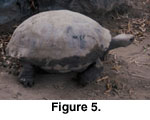 The tortoises were near adult
proportions, weighing approximately 130 – 175 kg and had a range in carapace
length from approximately 0.75 – 0.84 m and widths ranging from 0.50 to 0.60 m.
The tortoises were near adult
proportions, weighing approximately 130 – 175 kg and had a range in carapace
length from approximately 0.75 – 0.84 m and widths ranging from 0.50 to 0.60 m.
Sections of substrate were cleaned of previous
tracks with a broom. Tortoises were encouraged to walk across the cleaned
surfaces and the resulting tracks were photographed.
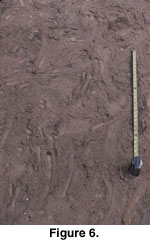 Tortoises were also
encouraged to change gait from a normal walk to a brisk walk by a gentle
tapping of a broom handle on the carapace. Such tapping typically increased the
pace of the turtles’ walk several fold. Track morphology of the footprints left
by the tortoises varied significantly. The variation was largely controlled by
the speed of the turtle and to a lesser extent by the substrate composition.
Tortoises were also
encouraged to change gait from a normal walk to a brisk walk by a gentle
tapping of a broom handle on the carapace. Such tapping typically increased the
pace of the turtles’ walk several fold. Track morphology of the footprints left
by the tortoises varied significantly. The variation was largely controlled by
the speed of the turtle and to a lesser extent by the substrate composition.
Sandy Substrate Tracks
Tracks in the drier sandy substrate
were largely indistinct, slight depressions in the sand.
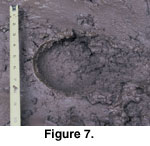 No claw marks were
observed in the tracks made by tortoises walking a normal pace across this
substrate. When the pace of the tortoise increased several fold, the tracks
became widely spaced and were distinct as sets of long grooves made by the
claws of each foot of the turtle sweeping across the sand (Figure
6). When
walking across a wet sandy substrate, the tracks were well defined, circular to
elliptical in shape, and often had a raised lip around the edge (Figure
7). Claw
impressions were often seen in these wet sandy tracks, but the claw marks were
commonly subtle in definition and typically not all claws left impressions
(Figure
7).
No claw marks were
observed in the tracks made by tortoises walking a normal pace across this
substrate. When the pace of the tortoise increased several fold, the tracks
became widely spaced and were distinct as sets of long grooves made by the
claws of each foot of the turtle sweeping across the sand (Figure
6). When
walking across a wet sandy substrate, the tracks were well defined, circular to
elliptical in shape, and often had a raised lip around the edge (Figure
7). Claw
impressions were often seen in these wet sandy tracks, but the claw marks were
commonly subtle in definition and typically not all claws left impressions
(Figure
7).
Muddy Substrate Tracks
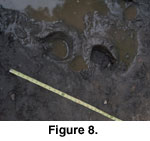 No tracks were observed on a dry
silty substrate. Tracks made by tortoises walking at a normal gait on a wet
silty substrate were well-defined circular to elliptical depressions 10 to 20
mm deep (Figure 8). As with the tracks made in a sandy substrate, these tracks
also exhibited a raised lip. The lips observed on these tracks made on the
fine-grained substrate, however, were much wider and rounded in comparison to
those tracks observed in a sandy substrate. Claw marks were sometimes evident
on these tracks. As the pace of the tortoise increased, the tracks became
widely spaced with sets of long grooves made by the claws of each foot sweeping
across the mud (Figure 9).
No tracks were observed on a dry
silty substrate. Tracks made by tortoises walking at a normal gait on a wet
silty substrate were well-defined circular to elliptical depressions 10 to 20
mm deep (Figure 8). As with the tracks made in a sandy substrate, these tracks
also exhibited a raised lip. The lips observed on these tracks made on the
fine-grained substrate, however, were much wider and rounded in comparison to
those tracks observed in a sandy substrate. Claw marks were sometimes evident
on these tracks. As the pace of the tortoise increased, the tracks became
widely spaced with sets of long grooves made by the claws of each foot sweeping
across the mud (Figure 9).


 Several specimens of large chelonid
Galapagos tortoises (Geochelone elephantopus) were made available by the
Philadelphia Zoo (Figure 4,
Figure 5). These animals were in an outdoor pen with
broad regions of sandy substrate or fine silty substrate. The moisture level in
the substrate varied from dry to saturated.
Several specimens of large chelonid
Galapagos tortoises (Geochelone elephantopus) were made available by the
Philadelphia Zoo (Figure 4,
Figure 5). These animals were in an outdoor pen with
broad regions of sandy substrate or fine silty substrate. The moisture level in
the substrate varied from dry to saturated.
 The tortoises were near adult
proportions, weighing approximately 130 – 175 kg and had a range in carapace
length from approximately 0.75 – 0.84 m and widths ranging from 0.50 to 0.60 m.
The tortoises were near adult
proportions, weighing approximately 130 – 175 kg and had a range in carapace
length from approximately 0.75 – 0.84 m and widths ranging from 0.50 to 0.60 m.
 No claw marks were
observed in the tracks made by tortoises walking a normal pace across this
substrate. When the pace of the tortoise increased several fold, the tracks
became widely spaced and were distinct as sets of long grooves made by the
claws of each foot of the turtle sweeping across the sand (Figure
6). When
walking across a wet sandy substrate, the tracks were well defined, circular to
elliptical in shape, and often had a raised lip around the edge (Figure
7). Claw
impressions were often seen in these wet sandy tracks, but the claw marks were
commonly subtle in definition and typically not all claws left impressions
(Figure
7).
No claw marks were
observed in the tracks made by tortoises walking a normal pace across this
substrate. When the pace of the tortoise increased several fold, the tracks
became widely spaced and were distinct as sets of long grooves made by the
claws of each foot of the turtle sweeping across the sand (Figure
6). When
walking across a wet sandy substrate, the tracks were well defined, circular to
elliptical in shape, and often had a raised lip around the edge (Figure
7). Claw
impressions were often seen in these wet sandy tracks, but the claw marks were
commonly subtle in definition and typically not all claws left impressions
(Figure
7).
 No tracks were observed on a dry
silty substrate. Tracks made by tortoises walking at a normal gait on a wet
silty substrate were well-defined circular to elliptical depressions 10 to 20
mm deep (Figure 8). As with the tracks made in a sandy substrate, these tracks
also exhibited a raised lip. The lips observed on these tracks made on the
fine-grained substrate, however, were much wider and rounded in comparison to
those tracks observed in a sandy substrate. Claw marks were sometimes evident
on these tracks. As the pace of the tortoise increased, the tracks became
widely spaced with sets of long grooves made by the claws of each foot sweeping
across the mud (Figure 9).
No tracks were observed on a dry
silty substrate. Tracks made by tortoises walking at a normal gait on a wet
silty substrate were well-defined circular to elliptical depressions 10 to 20
mm deep (Figure 8). As with the tracks made in a sandy substrate, these tracks
also exhibited a raised lip. The lips observed on these tracks made on the
fine-grained substrate, however, were much wider and rounded in comparison to
those tracks observed in a sandy substrate. Claw marks were sometimes evident
on these tracks. As the pace of the tortoise increased, the tracks became
widely spaced with sets of long grooves made by the claws of each foot sweeping
across the mud (Figure 9).
